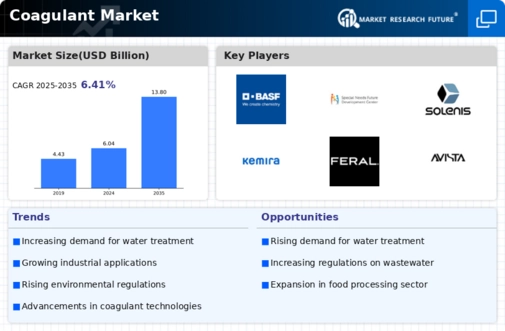Market Trends
Key Emerging Trends in the Coagulant Market
The coagulant market is experiencing notable trends influenced by various factors shaping consumer demands and industry dynamics. One significant trend is the increasing focus on water treatment and purification solutions, driven by growing concerns over water quality and environmental sustainability. As industries such as municipal water treatment, wastewater management, and industrial manufacturing seek efficient methods to remove impurities and contaminants from water sources, the demand for coagulants as primary treatment chemicals is on the rise. Coagulants play a crucial role in the flocculation process, enabling the aggregation and precipitation of suspended particles for easier removal, thus ensuring clean and safe water supply.
Moreover, there's a noticeable shift towards the adoption of alternative and eco-friendly coagulant formulations, driven by regulatory pressures and sustainability initiatives. Traditional coagulants, such as aluminum and iron salts, are facing scrutiny due to their environmental impact and potential health risks. In response, manufacturers are developing bio-based, biodegradable, and less-toxic coagulant options derived from natural sources or utilizing innovative chemical processes. These eco-friendly coagulants offer effective water treatment solutions while minimizing environmental harm and addressing public health concerns.
Additionally, technological advancements are driving innovation in the coagulant market, leading to the development of advanced coagulant products with improved efficiency and performance characteristics. Nanotechnology-based coagulants, for instance, offer enhanced particle removal capabilities and require lower dosages compared to conventional coagulants, thereby reducing overall treatment costs and minimizing chemical usage. Furthermore, continuous research and development efforts are focused on optimizing coagulant formulations and dosage strategies to achieve optimal treatment outcomes across various water treatment applications.
Furthermore, the market is witnessing increased demand for coagulants in emerging sectors such as the oil and gas industry, mining, and agriculture. In oil and gas production, coagulants are utilized for wastewater treatment and oil recovery processes, helping to remove contaminants and recover valuable resources while minimizing environmental impact. Similarly, in mining operations, coagulants are employed for water clarification and tailings management, improving water recycling and reducing freshwater consumption. In agriculture, coagulants play a role in soil stabilization and erosion control, supporting sustainable land management practices. The high demand of coagulants in this segment is attributed to large-scale consumption in municipal water treatment plants, and chemical and power industries. Further, with rapid industrialization and the development in the industrial sector, the discharge level of heavy metals and other solids in wastewater has elevated and emerged as environmental pollutants.
Moreover, the COVID-19 pandemic has had a significant impact on the coagulant market, with changes in consumption patterns and supply chain disruptions affecting industry dynamics. The increased demand for clean water and sanitation products amidst the pandemic has led to higher demand for coagulants used in water treatment and disinfection processes. However, supply chain challenges, including raw material shortages and logistical constraints, have posed challenges for coagulant manufacturers, prompting them to adapt their production and distribution strategies to meet evolving market demands.













Leave a Comment